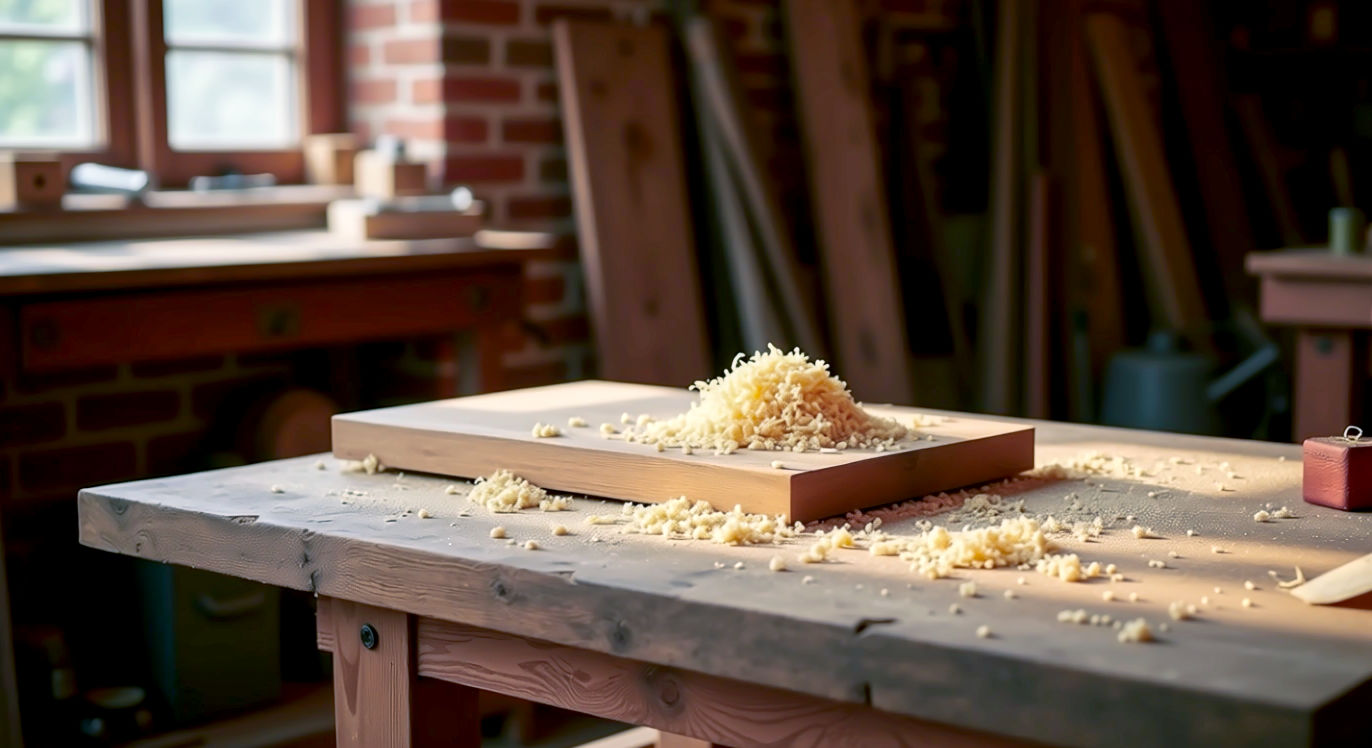The Triton TSPL152 Surface Planer Review: The Guide for the British Hobbyist Woodworker
Our in-depth review of the Triton TSPL152 Surface Planer. We cover unboxing, performance, pros, and cons for the British hobbyist woodworker.

This post may contain affiliate links. If you make a purchase through these links, we may earn a commission at no additional cost to you.
If you’ve ever tried your hand at woodworking, you’ll know the dream. It’s the vision of creating something beautiful and useful from a simple plank of wood – a sturdy bookshelf, a sleek coffee table, or a handcrafted gift that will be cherished for years. But you’ll also know the frustrating reality that often gets in the way: wonky wood.
You can buy the most gorgeous piece of oak or walnut from the timber yard, but if its faces and edges aren’t perfectly flat and square, your project is doomed before you’ve even made the first cut. Your joints will have gaps, your surfaces will rock, and the finished piece will just look… off. It’s a problem that has plagued woodworkers for centuries.
For a long time, the only solutions were either back-breaking work with a hand plane or spending a small fortune on a massive, industrial-grade machine. But what about the rest of us? The weekend warriors, the shed tinkerers, the passionate hobbyists working in a garage or a small workshop somewhere in the British Isles?
-
Allows for easy and accurate adjustment of cutting depth, with a maximum pass of 3.2mm.
-
Includes bench mounting holes to securely fix the planer in a workshop.
-
Features a dust extraction port for connecting to external dust extractors, ensuring a cleaner workspace.
-
Large infeed and outfeed tables provide added support for longer materials.
-
Equipped with a circuit breaker for enhanced electrical safety.
This is where the benchtop surface planer comes in. It’s a game-changing tool that brings precision woodworking into the realm of the home workshop. And one of the most talked-about contenders in this space is the Triton TSPL152.
But is it any good? Does it deliver on its promise of perfectly flat boards, or is it just another expensive gadget destined to gather dust? We’re going to find out. This is the ultimate, no-nonsense review of the Triton TSPL152 Surface Planer. We’ll get stuck into what it is, what it does, who it’s for, and whether it deserves a spot on your workbench.
First Things First: What Exactly is a Surface Planer?
Before we dive into the Triton machine itself, let’s clear something up. In the world of woodworking, names can be a bit confusing, especially when our friends across the pond in America use different terms.
What we in the UK often call a surface planer, Americans call a jointer.
They are the exact same machine. Their one and only job is to create one perfectly flat face on a piece of timber. Once you have that first flat face, you then use it to create one perfectly square edge (at a 90-degree angle to the face).
Think of it as the foundation of your entire project. Without a flat face and a square edge, you can’t get accurate results from any other tool, whether it’s a table saw or a router.
Surface Planer vs. Thicknesser: What’s the Difference?
This is the most common point of confusion for beginners, so let’s make it simple.
- A Surface Planer (or Jointer) creates a flat face and a square edge. It makes wood straight.
- A Thicknesser (or Thickness Planer) makes the opposite face parallel to the first flat face, bringing the board to a consistent thickness. It makes wood an even thickness.
You need both to turn a rough, twisted piece of wood into a perfectly square and dimensioned board (a process called S4S, or “surfaced four sides”). The Triton TSPL152 is only a surface planer. It does the first, most crucial part of the job. Many workshops have a separate thicknesser to complete the process.
Why Do You Need a Surface Planer in Your Workshop?
You might be wondering if you can get by without one. And for a while, you probably can. You can buy pre-planed timber (often called PSE, or “planed square edge”) from big-box DIY stores. But relying on this comes with three big problems:
- It’s Expensive: You pay a massive premium for wood that’s already been prepared for you. The cost adds up very quickly.
- It’s Not Always Flat: Wood is a natural material. It moves, twists, and warps as its moisture content changes. That “flat” board you bought from the shop might have developed a cup or a bow by the time it gets to your workshop. A surface planer lets you re-flatten it just before you use it.
- It Limits Your Creativity: The real magic of woodworking is finding a unique piece of rough-sawn timber – a slab of spalted beech or a plank of rippled ash – and revealing the beautiful grain hidden within. A surface planer unlocks this possibility. It allows you to buy cheaper, rougher wood and turn it into treasure.
In short, a surface planer gives you control, precision, and freedom. It elevates your woodworking from simple assembly to true craftsmanship.
Meet the Contender: The Triton TSPL152
Triton is a brand that many British hobbyists will be familiar with. Since starting in 1976, they’ve carved out a reputation for producing innovative and affordable tools aimed squarely at the serious DIYer and woodworking enthusiast rather than the industrial professional. They often bridge the gap between cheaper, less reliable brands and the eye-wateringly expensive professional gear.
The TSPL152 is their benchtop surface planer. The “152” in its name refers to its maximum planing width in millimetres (which is 6 inches). Let’s take a look at the key specifications from the manufacturer:
- Motor: 1100W (about 1.5 horsepower)
- Planing Width: 152mm (6 inches)
- Cutter Block Speed: 8,000 RPM
- Cuts Per Minute: 16,000 CPM (thanks to a dual-bladed cutter block)
- Maximum Cut Depth: 3.2mm (1/8 inch) in a single pass
- Table Size: 770mm x 260mm
- Fence: Extruded aluminium, tilts from 45° to 135°
- Weight: Around 20kg
On paper, it’s a solid set of numbers for a machine in this class. The 1100W motor is powerful enough for a 6-inch planer, and the 16,000 cuts per minute suggest it should leave a smooth finish. But as we all know, the real test is how it performs in the workshop.
Unboxing and Assembly: First Impressions
The Triton TSPL152 arrives in a large, heavy box. At 20kg, it’s not something you can just chuck around; it feels substantial, which is a good sign for a machine that needs to be stable.
The Dreaded Manual
Let’s get one thing out of the way first, because it’s a common theme in user reviews: the assembly instructions aren’t great. In an effort to cater to multiple languages, the manual separates the text, the diagrams, and the parts list onto different pages. This means you’ll find yourself constantly flipping back and forth, trying to match a cryptic instruction in English to a slightly murky illustration and a part number.
It’s a bit of a faff, to be honest. As one user wisely recommended, your best bet is to search for an assembly video on YouTube. Seeing someone actually put it together makes the whole process much clearer and will save you a good half hour of head-scratching.
What’s in the Box?
Once you have all the bits out, you’ll find:
- The main planer body
- The fence assembly
- A blade drum guard
- A push stick and two push blocks (essential safety gear)
- A hex spanner and a couple of hex keys for assembly and adjustments.
Assembly mainly involves attaching the fence and the blade guard. It’s not a complicated job, but the poor instructions can make it feel that way. Take your time, watch a video, and you’ll have it ready to go in under an hour.
A Closer Look: Build Quality and Key Components
Once assembled, the TSPL152 looks and feels like a proper bit of kit. It’s compact enough to sit on a sturdy workbench, but it has enough heft to feel stable. Let’s break down the important parts.
The Motor
The 1100W motor is housed underneath the main body. It’s an induction motor, which is generally quieter and more reliable than the universal motors found in cheaper power tools. It drives the cutter block via a belt. There’s a circuit breaker switch on the front for electrical safety, which is a thoughtful touch. When you switch it on, it gets up to speed quickly with a satisfying hum rather than a high-pitched scream.
The Tables (The Bed)
This is arguably the most important part of a surface planer. The TSPL152 has two main tables, an infeed table (where you start the wood) and an outfeed table (where the wood exits). The outfeed table is fixed, and the infeed table is the one you raise or lower to set the depth of your cut.
The tables are made of cast alloy. Now, this is a point of debate. In an ideal world, the tables would be made of heavy cast iron, which is incredibly stable and can be milled perfectly flat. Cast alloy is lighter and cheaper. For a benchtop machine designed to be portable, it’s a sensible compromise.
However, some users have reported issues. The main one is that the bed isn’t always perfectly flat out of the box. One reviewer noted a slight bow, while another said theirs wasn’t level and couldn’t be adjusted. This is the biggest potential pitfall with a machine at this price point. It’s crucial to check the tables for flatness as soon as you unbox it. Grab a reliable straight edge and run it across the tables in every direction. If you see significant gaps, you may have received a faulty unit.
The surface of the tables is simply painted, not milled smooth like on more expensive machines. This is a cost-saving measure and doesn’t hugely affect performance, but it’s a reminder that this is a hobbyist tool, not a professional one.
The Cutter Block and Blades
Sandwiched between the two tables is the cutter block. The TSPL152 uses a dual-bladed block, which means it has two straight knives. As the block spins at 8,000 RPM, these two blades provide 16,000 cuts every minute.
More cuts per minute generally means a smoother finish, as each cut is removing a smaller chip of wood. The blades that come with the machine are decent enough for softwoods like pine, but some users have noted they struggle a bit with hard, dense woods like oak. This is pretty standard for stock blades. The good news is that replacement blades are readily available and not too expensive, and upgrading to a higher-quality set can make a real difference to the machine’s performance.
Changing the blades is a fiddly job on any planer, but it’s a crucial bit of maintenance you’ll need to learn.
The Fence
A surface planer’s fence is vital for creating a perfectly square 90-degree edge. The Triton’s fence is a large piece of extruded aluminium. It’s one of the machine’s strongest features.
Many competing planers in this price range have flimsy, pressed-steel fences that are difficult to set and hold square. The Triton’s fence is much more substantial. Reviewers praise how solid the mechanism is, making it easy to set to 90 degrees and, crucially, keeping it there. It also tilts from 45 to 135 degrees, with preset stops to make finding common angles quicker.
That said, one user did mention their fence had a slight bow in it, a common issue with aluminium extrusions. They suggested that attaching a straight piece of plywood to the face could easily solve this, which is a great, practical tip.
The Adjustments
Setting the cutting depth is done via a rotating handle under the infeed table. It’s a simple, manual system. There’s no fancy digital readout or even a precise measurement gauge. You basically turn the handle a bit, make a test pass, and then adjust again if needed.
Is it basic? Yes. Does it work? Absolutely. This is a tool designed for taking several small, shaving-like passes rather than hogging off the maximum 3.2mm in one go. For the careful work required to flatten a board, this simple adjustment method is perfectly adequate.
Dust Extraction
Wood planers produce a phenomenal amount of wood shavings. Without good dust extraction, your workshop will look like the inside of a hamster’s cage in about 30 seconds.
The TSPL152 has a 60mm dust port on the side, and its performance here gets a big thumbs-up from users. When connected to a proper workshop vacuum or dust extractor, it’s reported to capture the vast majority of dust and shavings. This makes for a much cleaner, safer, and more pleasant working environment. Don’t even think about using this machine without hooking it up to some form of extraction.
In the Workshop: Putting the Triton TSPL152 to the Test
So, how does it all come together? Let’s imagine we’re taking a piece of rough-sawn pine, about a metre long, and giving it its first flat face and square edge.
- Setup: First, we place the planer on a solid workbench. We use the mounting holes to bolt it down for extra stability. We check the fence is set to a perfect 90 degrees using an engineer’s square. We connect our dust extractor hose to the port.
- Safety Check: We put on our safety glasses and ear defenders. We make sure the blade guard is in place and functioning correctly. We grab our push blocks.
- Setting the Depth: We lower the infeed table to take a very shallow cut, maybe half a millimetre. The key to surface planing is patience. Multiple light passes are better than one heavy one.
- The First Pass: We switch the machine on. We place the board on the infeed table, ensuring the ‘cup’ of the board is facing down, so it’s stable. We use the push blocks to apply gentle, even pressure downwards and forwards, guiding the board over the cutter head. The machine hums along nicely, peeling off a fine shaving of wood. The dust extractor whisks the shavings away instantly.
- Inspection and Repeat: We check the board. We can see where the blades have cut the high spots. We repeat the process, passing the board over the cutter head again and again. We don’t force it; we let the machine do the work. After a few passes, we have a surface that is glass-smooth and perfectly flat from end to end. The finish on the pine is excellent, requiring very little sanding.
- Creating a Square Edge: Now, we place our newly flattened face firmly against the fence. We run the adjacent edge over the cutter head. Because our fence is set to a true 90 degrees, the edge we create is perfectly square to the face.
The result is a board that’s ready for the next stage – heading to the thicknesser to make the other two sides parallel and square.
The process is straightforward and, frankly, incredibly satisfying. The machine feels solid in use. There’s very little vibration, and the large infeed and outfeed tables do a decent job of supporting the workpiece and preventing ‘snipe’ (when the planer takes a slightly deeper cut at the start or end of a board).
For hardwoods like oak, you’d need to take even lighter passes, and having sharp, high-quality blades would be essential. But for the pine, ash, and other common timbers used by British hobbyists, the Triton TSPL152 seems to handle the job with confidence.
The Good, The Bad, and The Quirky: A Balanced Verdict
No tool is perfect, especially in the affordable, hobbyist category. Let’s sum up the pros and cons based on the specs and real-world user feedback.
The Good Bits
The Not-So-Good Bits
So, Is the Triton TSPL152 Right for You?
This is the big question. The answer depends entirely on who you are and what you want to achieve.
The Triton TSPL152 is PERFECT for you if:
- You are a passionate hobbyist or serious DIYer who wants to take your woodworking to the next level.
- You are tired of paying a premium for pre-planed timber and want the freedom to use rough-sawn wood.
- You work in a small to medium-sized workshop (a garage, a large shed, etc.) and need a benchtop solution.
- You understand the importance of setup and are willing to take the time to check the machine for flatness and squareness.
- Your budget is limited, and you’re looking for the best performance you can get for your money.
The Triton TSPL152 is PROBABLY NOT for you if:
- You are a professional woodworker who needs a machine that can run reliably for eight hours a day. It’s just not built for that level of heavy use.
- You need to plane boards wider than 152mm (6 inches).
- You demand absolute, out-of-the-box perfection and aren’t prepared to potentially fettle or adjust the machine (or send it back if you get a bad one).
- You have the space and budget for a larger, cast-iron, floor-standing machine.
This machine sits in a fantastic sweet spot. It’s a significant upgrade from a handheld electric planer and offers a huge slice of the functionality of a professional machine for a fraction of the cost. It’s for the person who has mastered the basics and is ready to start building projects with real precision.
Getting the Best Results from Your TSPL152
If you do decide to buy one, here are a few tips to make sure you get the best possible performance from it:
- Check, Check, and Check Again: The moment it’s out of the box, use a reliable straight edge to check the infeed and outfeed tables for flatness. Check the fence for flatness and squareness to the tables. This five-minute check is the most important thing you will do.
- Take Your Time: Surface planing is not a race. Use multiple, shallow passes of 1mm or less. This puts less strain on the motor, gives a better finish, and is much safer.
- Read the Grain: Always try to plane “downhill” with the grain of the wood. Planing against the grain can cause the wood fibres to tear out, leaving a rough, chipped surface.
- Upgrade the Blades: When the stock blades start to get dull, consider replacing them with a high-quality set from a reputable brand. It’s a relatively cheap upgrade that can make a big difference.
- Keep it Clean: Regularly clean the tables and fence with a cloth and some wax polish. This prevents rust and allows the wood to glide smoothly over the surface.
-
Allows for easy and accurate adjustment of cutting depth, with a maximum pass of 3.2mm.
-
Includes bench mounting holes to securely fix the planer in a workshop.
-
Features a dust extraction port for connecting to external dust extractors, ensuring a cleaner workspace.
-
Large infeed and outfeed tables provide added support for longer materials.
-
Equipped with a circuit breaker for enhanced electrical safety.
The Final Word: A Game-Changer for the British Shed
So, what’s the final verdict on the Triton TSPL152 Surface Planer?
Despite a few quirks – namely the potential for an imperfectly flat bed and a manual that seems designed by a puzzle enthusiast – this machine is a resounding success for its target audience. It does what it says on the tin, and it does it well.
It’s a tool that democratises precision. It takes the fundamental woodworking task of creating flat and square stock and makes it accessible and affordable for the home workshop. The solid fence and effective dust collection are standout features that punch well above their price point, and the core performance is more than capable for any hobbyist’s needs.
If you’re ready to stop relying on expensive, often-unreliable pre-planed timber and want to unlock the true potential of your woodworking, the Triton TSPL152 is one of the very best investments you can make. It’s a reliable, powerful, and capable workhorse that will fundamentally change the way you build things. For the British hobbyist woodworker, it’s a genuine game-changer.
Further Reading:
- Woodworking UK Forum: A fantastic community forum for British woodworkers to ask questions and share advice.
- The English Woodworker (Blog): A great resource for traditional and hand-tool woodworking techniques, which provides a good foundation for understanding wood.
- Axminster Tools – Skill Centre: A leading UK tool retailer with a huge library of articles, videos, and guides on how to use woodworking machinery safely and effectively.







